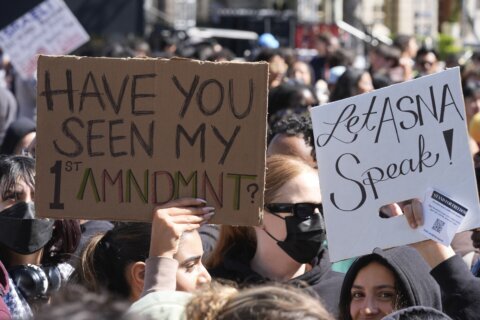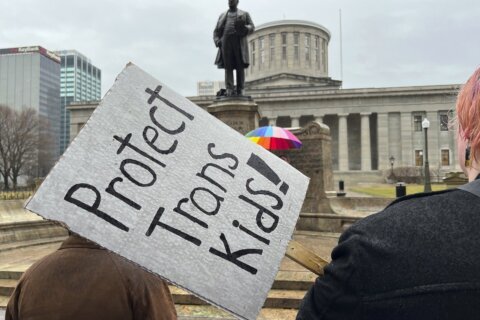Leaving college with large amounts of student loan debt can often delay a graduate’s decision to earn an advanced degree, buy a house or contribute to their retirement plan, in turn affecting lifetime earnings and wealth.
Black graduates — who as a group owe $25,000 more in student loans on average compared to their white counterparts, according to 2021 data from the National Center for Education Statistics — are largely affected by a generational wealth gap.
So, too, are historically Black colleges and universities, which predominantly serve Black students, says David A. Thomas, president of Morehouse College, a renowned private HBCU in Atlanta. Compared to other private institutions, private HBCUs typically have smaller endowments, which largely depend on alumni giving, Thomas adds.
“Even for families where the parents are college educated and have had steady employment, because they got a later start being able to generate wealth, they’re able to do less for the next generation,” he says. “Their kids, their nephews, etc. The effects ripple through the communities. To the positives for the white community and very much to the negative for the Black community.”
What Are HBCUs?
Founders began to establish HBCUs during a time when Black people were legally prohibited from earning an education. Cheyney University of Pennsylvania became the nation’s first HBCU in 1837, paving the way for over 100 such institutions to form over the decades.
[Read: A Guide to HBCUs. ]
HBCUs represent only about 3% of the nation’s higher education institutions, but they enroll 10% of all Black students and generate nearly 20% of all Black graduates, according to a study by the United Negro College Fund, a philanthropic organization that funds scholarships for Black students and HBCUs.
“The colleges are underinvested in, like many African Americans and their communities are underinvested in,” says Lodriguez Murray, the UNCF’s senior vice president of public policy and government affairs. “Originally they enrolled the progeny of slaves. They tend to enroll in modern times, still, a majority of first-generation college students and students from underserved backgrounds.”
More than 70% of HBCU students are federal Pell Grant-eligible, which indicates significant financial need, according to the UNCF.
To address those needs, HBCUs have implemented financial strategies over the years to make obtaining a college degree more affordable, beginning with lower tuition fees.
How Much Does it Cost to Attend an HBCU?
Tuition costs vary at each institution, but HBCUs are generally less expensive than other four-year private and public nonprofit institutions.
For example, the published tuition and fees for the 2021-2022 school year at Spelman College, another prestigious private HBCU in Atlanta, is $28,181, while a neighboring private institution in Georgia, Agnes Scott College, charged about 57% more at $44,250.
Public regional HBCUs like Norfolk State University in Virginia, at $9,622 for the 2021-2022 year, charged around $5,000 less for in-state students than Longwood University and Christopher Newport University, other public regional institutions in the state.
But tuition cost is just part of the sticker price, which doesn’t necessarily go much lower at HBCUs after financial aid is applied.
“HBCUs don’t have as much money to put towards institutional scholarships and institutional aid, so occasionally the cost can be end up not being as low as you think or being similar,” says Marybeth Gasman, an endowed chair in education and distinguished professor at Rutgers University–New Brunswick in New Jersey.
[READ: 10 Historically Black Colleges Where Alumni Donate the Most.]
“But overall, they are still offering education at a much lower cost,” she adds. “If you have a constituency that (largely relies on financial aid) and your whole mission is dedicated to African American student success and moving African Americans into the middle class and beyond, you really can’t charge exorbitant tuition prices. Because (a lot of) your student population and even beyond that, the students’ family population, can’t afford it.”
Programs That Reduce Student Loan Borrowing at HBCUs
To address the generational impact of borrowing, Morehouse developed the College Student Success Program to allow students to pursue advanced degrees without the barrier of undergraduate loans.
Billionaire Robert F. Smith, founder, chairman and CEO of Vista Equity Partners, kick-started the program’s fundraising campaign two years ago by announcing a $34 million donation during his commencement address, which would go toward paying off student loans accumulated by the 2019 graduating class.
This catapulted support from other donors. Most recently, billionaire Reed Hastings, co-founder and chief executive officer of Netflix, and his wife, philanthropist Patty Quillin, donated $40 million to the program, as well as $40 million each to Spelman and the UNCF.
But institutions like Morehouse are not alone in finding ways to reduce student loan debt.
Newly appointed president Michael J. Sorrell changed the structure of Paul Quinn College, a Texas HBCU on the verge of closure when he took the helm in 2007. Putting affordability at the forefront, his administration took steps such as lowering tuition, transitioning to using open source materials and implementing a work program.
In 2017, Paul Quinn became the ninth federally funded work college in the U.S. and the first HBCU to join those ranks, per designation by the U.S. Department of Education. All full-time students are required to work at least 10 hours per week, earning scholarships and stipends for their participation. Since its establishment, the program has substantially reduced student debt at the college, dropping by nearly $30,000 on average per student, according to Sorrell.
“For institutions that are willing to reach a little bit, be creative and challenge the notions of institutional structure and traditions, this model will award them richly,” he adds. “I could not stomach students borrowing $40,000 in total to pay for college.”
Additionally, Miles College in Alabama is among several HBCUs to partner with the Society for Financial Education & Professional Development Inc. to educate families and students about loans and other aspects of personal finance.
Efforts to address affordability challenges increased with the onset of the coronavirus pandemic, which some data indicates has had a disproportionately negative impact on communities of color.
With students and families facing job losses, pay cuts and housing and food insecurity, the federal Coronavirus Aid, Relief, and Economic Security Act, also known as the CARES Act, was passed in March 2020 to provide relief. As part of that, more than $1 billion was designated specifically for HBCUs and other minority-serving institutions.
In recent months, Florida A&M University joined more than 20 HBCUs in using some of the funding to clear outstanding student debt to the respective schools.
FAMU, for example, used the funds to pay more than $16 million in institutional debt for students with unpaid account balances during the 2020-2021 school year. Students will receive an additional $41.5 million in tuition and fee assistance for 2021-2022.
Scholarship Opportunities for HBCU Students
In addition to COVID-19, heightened awareness of racial injustice and the election of Kamala Harris — an HBCU graduate — as vice president have helped generate an influx of donations to HBCUs. Author and billionaire philanthropist MacKenzie Scott, the former wife of Amazon founder Jeff Bezos, has donated at least $560 million to more than 20 HBCUs.
[READ: Where to Find Scholarships for Black Students]
Adobe, Pepsi and Verizon are among companies that have created scholarships at various HBCUs over the last year. Also, the Gates Millennium Scholars Program, funded by the Bill & Melinda Gates Foundation, has awarded more than $1.2 billion in scholarships from 2000-2018 to support students of color, according to the latest numbers on the program’s website.
Beyond institutional scholarships, the UNCF and the Thurgood Marshall College Fund offer scholarships to fill financial aid gaps and to cover costs of tuition, fees and room and board.
Last year, for example, the UNCF revamped its Community Student Aid program to address the areas of general emergency aid, degree completion, housing insecurity, food insecurity and disaster relief, according to James Lander, director of scholarships and programs at UNCF.
“By taking a more comprehensive look at our aid program, it allows more flexibility and it allows it to be able to respond to the specific needs of our student population and our institutions,” he says.
More from U.S. News
What to Know About the Common Black College Application
11 Historically Black Schools With the Highest 4-Year Graduation Rates
Repayment Resources for Minority Student Loan Borrowers
How HBCUs Are Addressing the Cost of College originally appeared on usnews.com







